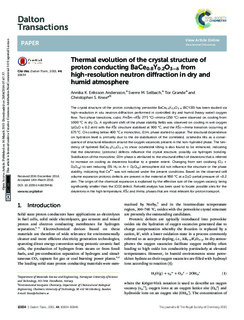| dc.contributor.author | Eriksson Andersson, Annika Kristina | |
| dc.contributor.author | Selbach, Sverre Magnus | |
| dc.contributor.author | Grande, Tor | |
| dc.contributor.author | Knee, Christopher S | |
| dc.date.accessioned | 2016-04-28T07:15:27Z | |
| dc.date.accessioned | 2016-04-29T11:49:47Z | |
| dc.date.available | 2016-04-28T07:15:27Z | |
| dc.date.available | 2016-04-29T11:49:47Z | |
| dc.date.issued | 2015 | |
| dc.identifier.citation | Dalton Transactions 2015, 44(23):10834-10846 | nb_NO |
| dc.identifier.issn | 1477-9234 | |
| dc.identifier.uri | http://hdl.handle.net/11250/2388091 | |
| dc.description.abstract | The crystal structure of the proton conducting perovskite BaCe0.8Y0.2O3−δ (BCY20) has been studied via high-resolution in situ neutron diffraction performed in controlled dry and humid (heavy water) oxygen flow. Two phase transitions, cubic Pm3¯m→R3¯c (775 °C)→Imma (250 °C) were observed on cooling from 1000 °C in dry O2. A significant shift of the phase stability fields was observed on cooling in wet oxygen (pD2O ≈ 0.2 atm) with the R3¯c structure stabilised at 900 °C, and the R3¯c→Imma transition occurring at 675 °C. On cooling below 400 °C a monoclinic, I2/m, phase started to appear. The structural dependence on hydration level is primarily due to the de-stabilisation of the correlated, octahedra tilts as a consequence of structural relaxation around the oxygen vacancies present in the non-hydrated phase. The tendency of hydrated BaCe0.8Y0.2O3−δ to show octahedral tilting is also found to be enhanced, indicating that the deuteronic (protonic) defects influence the crystal structure, possibly via hydrogen bonding. Stabilisation of the monoclinic I2/m phase is attributed to the structural effect of deuterons that is inferred to increase on cooling as deuterons localise to a greater extent. Changing from wet oxidising (O2 + D2O(g)) to wet reducing (5% H2 in Ar + D2O(g)) atmosphere did not influence the structure or the phase stability, indicating that Ce4+ was not reduced under the present conditions. Based on the observed cell volume expansion protonic defects are present in the material at 900 °C at a D2O partial pressure of ∼0.2 atm. The origin of the chemical expansion is explained by the effective size of the oxygen vacancy being significantly smaller than the [OD] defect. Rietveld analysis has been used to locate possible sites for the deuterons in the high temperature, R3¯c and Imma, phases that are most relevant for proton transport. | nb_NO |
| dc.language.iso | eng | nb_NO |
| dc.rights | Navngivelse-Ikkekommersiell 3.0 Norge | * |
| dc.rights.uri | http://creativecommons.org/licenses/by-nc/3.0/no/ | * |
| dc.title | Thermal evolution of the crystal structure of proton conducting BaCe0.8Y0.2O3-δ from high-resolution neutron diffraction in dry and humid atmosphere | nb_NO |
| dc.type | Peer reviewed | nb_NO |
| dc.type | Journal article | nb_NO |
| dc.date.updated | 2016-04-28T07:15:27Z | |
| dc.description.version | publishedVersion | |
| dc.source.pagenumber | 10834-10846 | nb_NO |
| dc.source.volume | 44 | nb_NO |
| dc.source.journal | Dalton Transactions | nb_NO |
| dc.source.issue | 23 | nb_NO |
| dc.identifier.doi | 10.1039/c4dt03948c | |
| dc.identifier.cristin | 1256233 | |
| dc.description.localcode | This article is licensed under a Creative Commons Attribution-NonCommercial 3.0 Unported Licence. | nb_NO |

